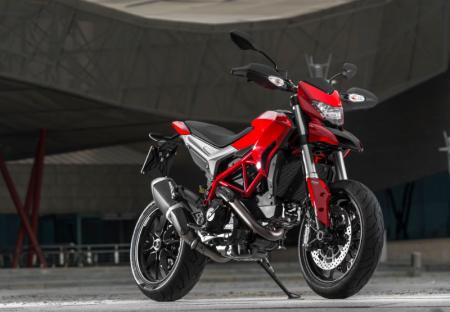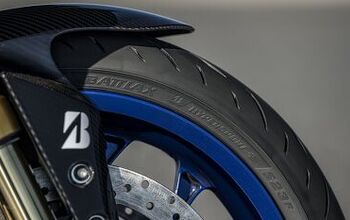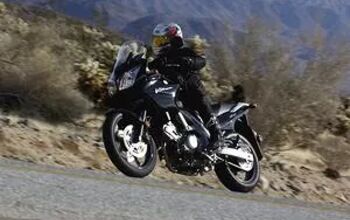2013 Ducati Hypermotard 821 Review - Motorcycle.com
There’s a reason why I avoid riding the Ducati Hypermotard. Whether it’s the 796 or 1100 versions, I inevitably do something stupid and put my license at risk. From lofting wheelies, sliding the back tire, or hopping on sidewalks, the Hyper is a capable and tempting machine to perform all kinds of tomfoolery.
Of course, its real purpose is to slice through the tightest asphalt ribbons one can find, and at this task we’ve proven it performs quite well. But 2013 sees the introduction of a new Hypermotard; one that ditches the air-cooled engines for a liquid-cooled, 821cc four-valver dubbed Testastretta II.
And when I was informed the testing grounds for Ducati’s hooligan bike would be the roads of Southern Spain and the breathtaking Ascari Race Resort, temptation was impossible to resist.
Our day was split in half, with the morning dedicated to street riding the standard $11,995 Hyper, and the afternoon spent flogging the up-spec $14,695 SP on track. But there was a problem: temperatures hovered just above freezing as we mounted the redesigned Hyper.
Mix the warning about black ice on the roads with little wind protection from the bike and inadequate clothing, and any thoughts of carving twisty Spanish roads were replaced with simply staying warm and upright.
More Gentlemanly, Still Hyper
However, that doesn’t mean all was lost. Just sitting on the new bike I noticed I was in a more relaxed position compared to its predecessor. Bars are higher and closer to the rider, pegs are pushed forward and seat moved rearward. Now I’m no longer peering over the front tire like before, instead seated upright with an actual view of the motorcycle underneath me.
The bike is all new from the ground up, including a redesigned steel trellis frame and aluminum die-cast subframe. Chassis geometry figures are all slightly relaxed compared to its predecessor for added stability. Rake is now 25.5 degrees (from 24.0 degrees), and trail is 4.1 inches (from 3.9 inches). Wheelbase is longer as well, up from 57.6 inches to 59.2.
Maintaining the Hypermotard look was important, according to Project Manager Marco Sairu. This meant keeping the beak-like nose, slim waistline, tall stance and dirtbike-on-steroids appearance, all while giving the rider more comfort and longer range, thanks to the aforementioned ergo changes and larger 4.2-gallon tank (from 3.3).
The big change in 2013 is the all-new, 821cc liquid-cooled, four-valve Testastretta II serving as the sole engine choice. In essence, you could call it a stroked version of the 803cc engine from the 796, as it shares the same 88mm bore as the previous 796 mill, but stroke is up to 67.5mm, from 66mm before. Of course cylinder heads are different to suit the liquid-cooling and four valves, while compression is upped to 12.8:1.
Like its Multistrada sibling, the new engine also shares the 11-degree valve overlap, sacrificing some peak power for usable midrange. And on these roads, this midrange flexibility was on full display. Darting from switchback to switchback was largely a third gear affair, though shifts with the new APTC wet clutch (with slipper function) were seamless in either direction.
Ducati claims the new engine puts out 110 hp, 20 more than the 1078cc engine of yesteryear’s 1100. However, the 65.8 ft.-lbs. is ten shy of the 1100 — there’s no replacement for displacement, after all. Though the extra torque is missed, there’s still plenty to loft the front tire off the ground.
According to Sairu, the change to the new engine is to meet the power characteristics Ducati were after, while meeting strict Euro 3 emission regulations. “It’s difficult to achieve horsepower improvements now without water-cooling,” he said, leaving open the possibility of a more powerful version of the Hyper engine in the future.
Thanks to ever improving manufacturing techniques, the Testastretta II sees service intervals increase to 15,000 km (9300 mi), with major service now required at 30,000 km (18,600 mi). The new Hyper is also the first of the line to receive ride-by-wire throttle and individual throttle bodies, all controlled by a Magneti Marelli engine management system.
Of course, the electronic throttle makes it easier to facilitate the eight-level Ducati Traction Control and three ride modes: Sport, Touring and Urban. The first two deliver the full 110 hp in descending levels of urgency, while Urban curtails power to 75 hp. Sport puts DTC and ABS in low settings, Touring places both in the middle, and Urban cranks the safety nannies to high.
Bosch provides the brain power behind the sophisticated ABS system of the Hypermotard. The 9MP unit is extremely small, weighing less than two pounds, and integrates three different ABS settings (including off).
Level 1 allows significant rear wheel lift, while Level 2 does its best to keep both wheels on the ground and spinning at all times. Ride modes, DTC and ABS are independently adjustable as the rider desires, though DTC and ABS must be done at a standstill. Best of all, the settings are remembered by the ECU after the bike is turned off.
Technologies like these exist for crappy conditions like our ride day. I started the ride in Touring mode, DTC set to 4 and ABS at 2. As these systems have become more sophisticated, it’s sometimes hard to notice intervention.
The gentle nature at which Touring mode delivers power, however, was softer than I preferred. A simple tap of the toggle with the left thumb switches to the sharper response of Sport mode and, together with the tall gearing, equals healthy amounts of torque delivered at a rate easily digestible for most riders.
Kayaba provides a 43mm, non-adjustable fork, with a Sachs shock in the rear adjustable for preload and rebound. Brembo four-pot monobloc calipers bite on 320mm discs in front and a 245mm disc sits out back with a twin-piston caliper. The Brembo bits work in typical Brembo fashion, but conditions simply weren’t safe to really test the suspension other than to say it provides a firm yet supple ride.
Hypermotard SP
As luck would have it, the sun was shining on the Ascari Race Resort as we finished our cold street ride on the standard Hypermotard and switched to the performance-minded SP for track laps.
While the engine is the same between both models, the SP sports some flashy bling bits like carbon fiber cam belt covers, magnesium valve covers and carbon fiber fenders. The SP also benefits from forged Marchesini wheels, weighing two kilograms less than the cast pieces on the standard model. Pirelli Supercorsa SP tires replace the Diablo Rosso II tires on the base model.
Ducati chose to equip a fully adjustable Marzocchi 50mm fork to the SP, a similar unit to that seen on the base 1199 Panigale. An Ohlins shock is directly mounted and also offers full adjustability. Front suspension travel is 7.3 inches, rear 6.9, compared to 6.7 inches and 5.9 inches, respectively, on the standard, and is largely responsible for the 8.3-inch ground clearance compared to 7.5 inches on the base model.
Other differences include an aluminum handlebar instead of the standard’s steel unit, and a Brembo radial master cylinder with an 18mm piston instead of the standard’s axial m/c and 16mm piston. Riding modes are now called Race, Sport and Wet but have the same function. An additional ABS mode, not available on the standard model, has minimal intervention up front and none in the rear, perfect for backing it in.
Before turning a wheel on track, you can’t help but notice the SP’s 35-inch seat height (34.2 inches on the standard model) is rather high, due to the long-travel suspension. An accessory low-seat is available with re-shaped seat foam, shaving almost an inch.
With the tarmac warming up and my limbs properly thawed, it was time to spin laps. None of the bikes were equipped with tire warmers, yet with ambient temperatures in the high 40s/low 50s, the stock Supercorsa SP tires came into their own after just a single lap. Impressive.
The best way to describe the 821 Testastretta II’s character is “friendly.” Even in race mode, power delivery is manageable and far from overwhelming. This character blends well with the rest of the motorcycle, as every component works in harmony to create a confidence-inspiring machine.
In a word, the new Hyper is fun. Rowing through the gears I never missed a shift in either direction, as it’s very smooth and engaging — a sentiment shared by other journos in attendance. The flexible nature of the engine was well suited to Ascari’s tight, curvy layout. The SPs suspension components were dialed in well for the track — I didn’t feel the need to adjust a single clicker.
Redline is set at 9700 rpm, with peak power coming at 9250, though there’s an impressive amount of overrun for a long-stroke V-Twin. Fortunately the soft rev limiter serves as a gentle reminder to shift. DTC interrupts ignition instead of cutting fuel and, honestly, if it did activate, I didn’t notice it.
The wide bars provide ample leverage to throw the Hyper into corners, but with such little weight up front, I noticed a slight vagueness from the front end. Body placement helps remedy this, and over time I learned to trust it would go where I pointed it, but it’s difficult to be inch-perfect in line selection without front-end confidence.
We’ve come to expect nothing but greatness from Brembo monobloc calipers, and the binders here are no different. Braking power is strong and linear. For my tastes, the ABS kicks in too soon in Sport mode. Switching to Race mode reduces ABS intervention and allows rear-wheel lifting and skidding.
For its intended purpose, attacking curvy roads and simply running amok, the Hypermotard is a winner. But even with the bigger tank, the relatively narrow seat and lack of wind protection or storage space means it’s not a machine I’d want to log long miles in.
Most of my gripes can be remedied with items from the Ducati accessories catalog, but at that point, why not opt for the forthcoming Hyperstrada?
After establishing the Hypermotard as a huge smile inducer, the question is whether owners of the previous version should step up, and whether the SP is worth the significant price jump over the base model. Personally, I wouldn’t make the switch if I owned the 1100 ’Tard, though I’d give serious consideration if I had the 796.
Is the SP worth it? This one is a no-brainer; the SP provides significantly more performance potential compared to the standard model. Upgrading the suspension alone would nearly match the price difference, and swapping wheels would make up the balance, and then some. Whichever route you take, the Hypermotard is still a leading candidate for putting your license at risk.
Related Reading
2010 Ducati Hypermotard 1100 EVO Review
EICMA 2012: 2013 Ducati Hypermotard Gets New 821cc Liquid-Cooled Engine
2010 Ducati Hypermotard 1100 EVO & EVO SP Review
2007 Ducati Hypermotard 1100S
2010 Ducati Hypermotard 796 Review
2010 Aprilia Dorsoduro 750 vs. Ducati Hypermotard 796
More by Troy Siahaan










































Comments
Join the conversation